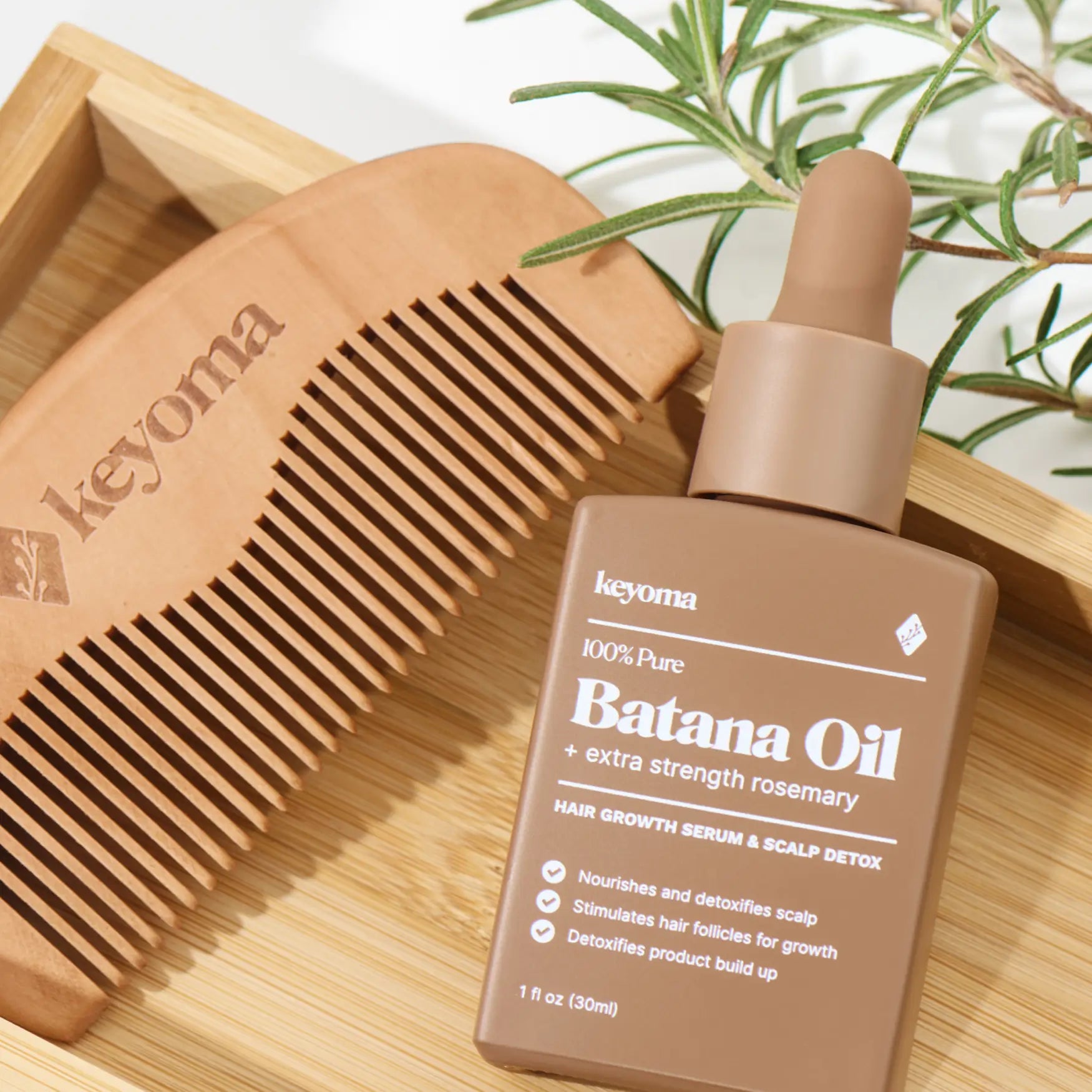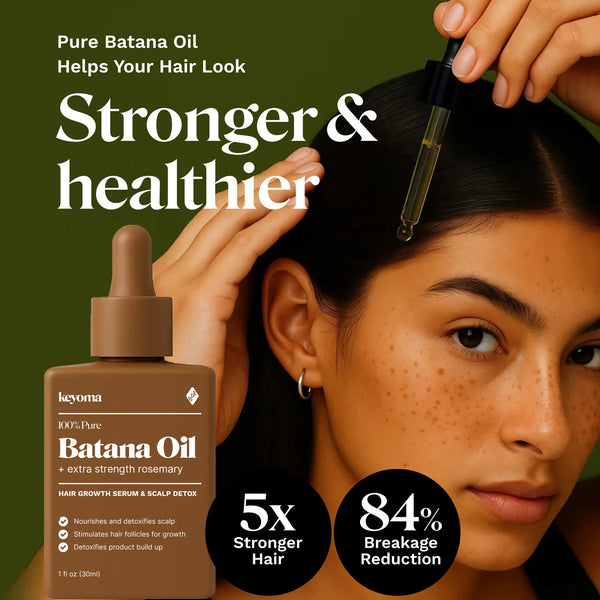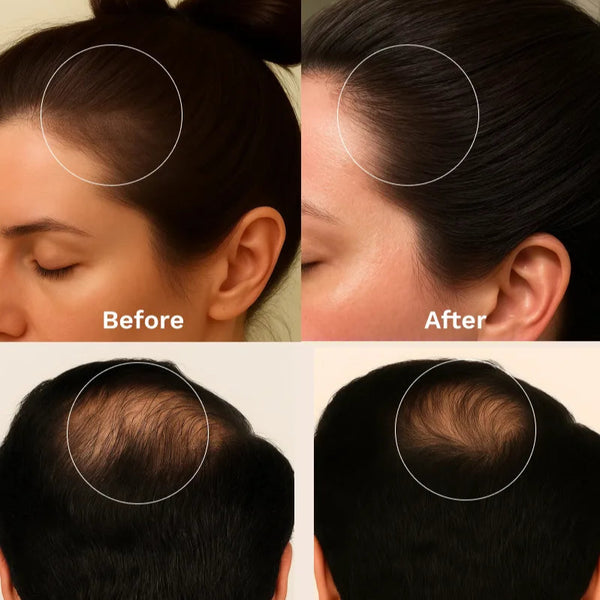In this article
Men and women share some traits, but our hair loss experiences can differ a lot. Both groups often face androgenetic alopecia—commonly called male or female pattern baldness. This condition follows a predictable pattern and stems from a hormone called DHT (dihydrotestosterone). For men, DHT comes from testosterone. For women, it develops from estrogen.
DHT mainly affects the hair follicles on the top of the scalp, leading to shedding in that area.
But that’s where the similarities stop. Since our bodies react to DHT in unique ways, we need to follow different approaches to manage and treat hair loss effectively.
What Causes Pattern Baldness in Men and Women
To develop male or female pattern hair loss, two things usually need to happen: you inherit the right genes, and your body has active androgens. It is not caused by just one gene either. This trait gets passed down through a mix of genetic factors.
Hormones like testosterone and dihydrotestosterone (DHT) are the main players here. Your body converts testosterone into DHT with the help of an enzyme called 5-alpha-reductase. And once DHT is in the picture, it starts targeting certain hair follicles—the ones your genes have marked as extra sensitive.
At first, those follicles just shrink. The hair they produce becomes thinner, shorter, and weaker. But over time, especially as you get older, those same follicles might stop growing hair completely.
That is when hair loss becomes more noticeable. And unfortunately, if your genes have already flipped that switch, it is tough to reverse.
What Male Pattern Baldness Looks Like

For most men, hair thinning starts with a receding front hairline. You’ll usually notice the temples begin to thin first, followed by the center of your hairline. Over time, more strands fall out and the entire front starts moving farther back.
As hair loss progresses, the crown or back of your scalp begins to thin. You might see patchy areas or an expanding bald spot near the crown.
In the later stages, the thinning areas at the front and crown connect, leaving the top of your head completely bare. Hair along the sides and back usually stays intact. These strands resist DHT and are often used during hair transplant procedures because they tend to stay healthy.
What Female Pattern Baldness Looks Like

Just like men, women can also experience hair loss caused by DHT. The main difference is how it shows up.
For most of us, it does not start at the temples. Instead, thinning usually begins at the center of the scalp. Over time, it spreads outward toward the sides. You might first notice that your part looks wider than normal. That little change is often the first clue something is off.
Some women also see thinning at the front hairline before it moves back toward the crown. And in more advanced stages, the hair above the ears may start to lose volume. The sides can get noticeably thinner too.
It does not always follow the same pattern, but once you notice it, it is hard to ignore.
Difference Between Male and Female Pattern Baldness
Male and female pattern hair loss share some traits, but they also differ in key ways. Both usually follow a set pattern, though that pattern shows up differently in men and women.
Men typically lose hair along the front and crown of the scalp. We, on the other hand, tend to see thinning at the top of our head, especially around the center part, which often starts to widen.
Another big difference lies in how hair loss affects our mental health. A review of more than 35 studies found that men with pattern hair loss usually report mild to moderate changes in quality of life. Most don’t face serious anxiety or depression. In fact, their mental health tends to match or exceed those without hair loss.
But for many of us, the emotional weight is heavier. Several studies link female hair thinning with higher rates of depression. One 2023 study showed that women with hair loss face a much higher risk of long-term stress and mood issues.
Can Pattern Baldness Be Reversed?
Hair loss can last for a short time or become long-term, depending on what's causing it. Some medicines trigger shedding, but once you stop taking them, your hair often grows back. Hormonal shifts, like the ones we face after pregnancy, often lead to thinning about three months after giving birth.
Balding also happens naturally as we get older. By age 50, up to half of all men show signs of male pattern hair loss. For us, female pattern thinning tends to start after menopause. Treatments exist for both men and women that can slow or even partially reverse this kind of hair loss.
How to Treat Pattern Baldness (Men and Women)

Pattern baldness, or androgenetic alopecia, affects both men and women. Women often experience diffuse thinning, while men typically notice a receding hairline or bald spots. The treatments below are arranged from basic to more intensive options, so you can explore what works best for your needs.
Natural Oils for Thinning Hair
Using plant-based oils is a gentle, accessible way to support scalp health and hair growth.
-
Batana oil: Deeply nourishing and rich in fatty acids that help restore damaged follicles.
-
Rosemary oil: Believed to improve scalp circulation and promote growth.
-
Peppermint oil: Creates a cooling effect and may stimulate hair follicles.
-
Lavender oil: Known for calming inflammation and maintaining a balanced scalp.
These oils can be applied directly or mixed with carrier oils like coconut or jojoba for daily scalp massage.
Using Minoxidil for Hair Loss
You can use minoxidil as a topical treatment to slow hair thinning and support longer growth cycles. You’ll find it in 2% and 5% strengths, and both men and women use it directly on the scalp. But once you stop applying it, new hair growth usually halts.
We don’t recommend using minoxidil if you're pregnant or breastfeeding. Always check with your doctor first.
Spironolactone for Female Pattern Baldness
Doctors often prescribe spironolactone to women to help block androgens, which are hormones linked to hair thinning. By lowering these hormone levels, the medication can slow or stop further hair loss.
Most men don’t use spironolactone for this purpose. It’s mainly recommended for women dealing with hormone-related shedding.
Finasteride for Male Pattern Baldness
Doctors often prescribe finasteride to men to lower DHT, the hormone that causes male-pattern hair loss. You take it once a day to slow shedding and support regrowth.
While some postmenopausal women may use it off-label, it’s not usually safe for women who could become pregnant because of possible side effects.
Microneedling for Hair Regrowth
When we use microneedling, we create small punctures in the scalp with fine needles. This triggers your body’s natural repair process and increases collagen production.
By doing this, we help wake up inactive follicles. You can pair microneedling with topical treatments like minoxidil to improve results.
Low-Level Laser Therapy (LLLT) for Thinning Hair
We can use handheld or wearable laser tools for low-level laser therapy (LLLT) to energize our follicles and increase blood circulation in the scalp.
You can do this non-invasive treatment at home or visit a clinic. With consistent use, you may see fuller, denser hair as time goes on.
Platelet-Rich Plasma (PRP) Therapy for Pattern Baldness
We use your own blood for platelet-rich plasma (PRP) therapy. After drawing it, we separate the platelets, then inject the plasma into your scalp.
These platelets release growth signals that can activate your follicles and boost hair density. You usually need monthly sessions at first to see results.
When Hair Transplant May Be an Option
In a hair transplant, we move healthy follicles from thicker parts of your scalp to areas where you see thinning or bald spots.
You might consider this procedure if other treatments haven’t worked. While more common for men, some women also choose this option when suitable.
Reclaim Your Hair Confidence With Keyoma's Natural Approach
Male and female pattern hair loss often results from aging, but other factors—like shifting hormones, prescriptions, and medical conditions—can also trigger shedding. Some causes are reversible, while others are not.
If you're seeing more strands than usual, connect with a dermatologist who specializes in hair loss. They can help you figure out what's going on and build a plan to restore your hair.
You can also take the first step at home. Start with natural scalp care. Try Keyoma’s batana oil to support regrowth, improve scalp health, and protect your strands from breakage.
Featured Product
100% Pure Batana Oil + Rosemary
↓Best Batana Oil to Buy↓
1 Month
Subscribe & Save
- 30-day supply delivered monthly $35
- 30% off for life $6
- Free haircare essentials kit $33
- Free custom wooden comb $10
- Free scalp massager $15
- Free eco-friendly travel bag $8
- 30-Day Money Back Guarantee
- Free Shipping
- Online portal for easy cancel, skip, or pause.
1 Month One Time Purchase

- 30-day supply $50
- 30% off for life $6
- Free haircare essentials kit $33
- Free custom wooden comb $10
- Free scalp massager $15
- Free eco-friendly travel bag $8








